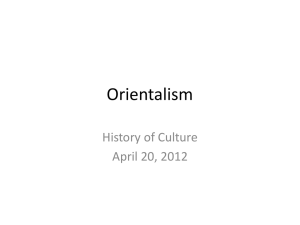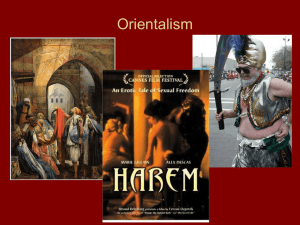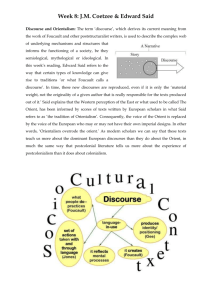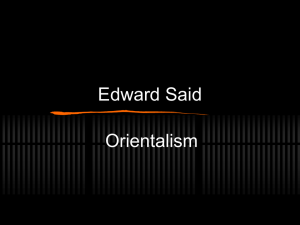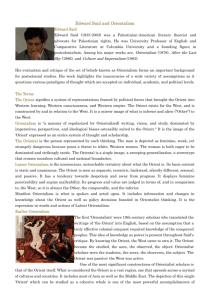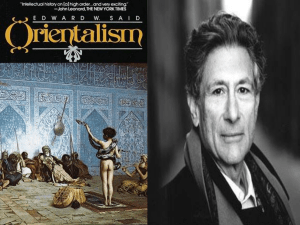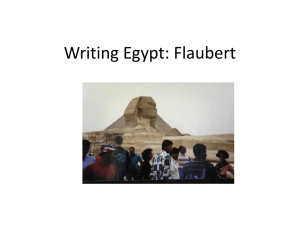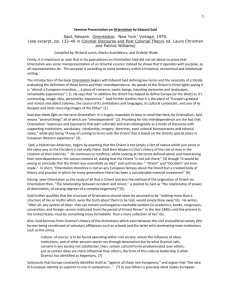Orientalism
advertisement
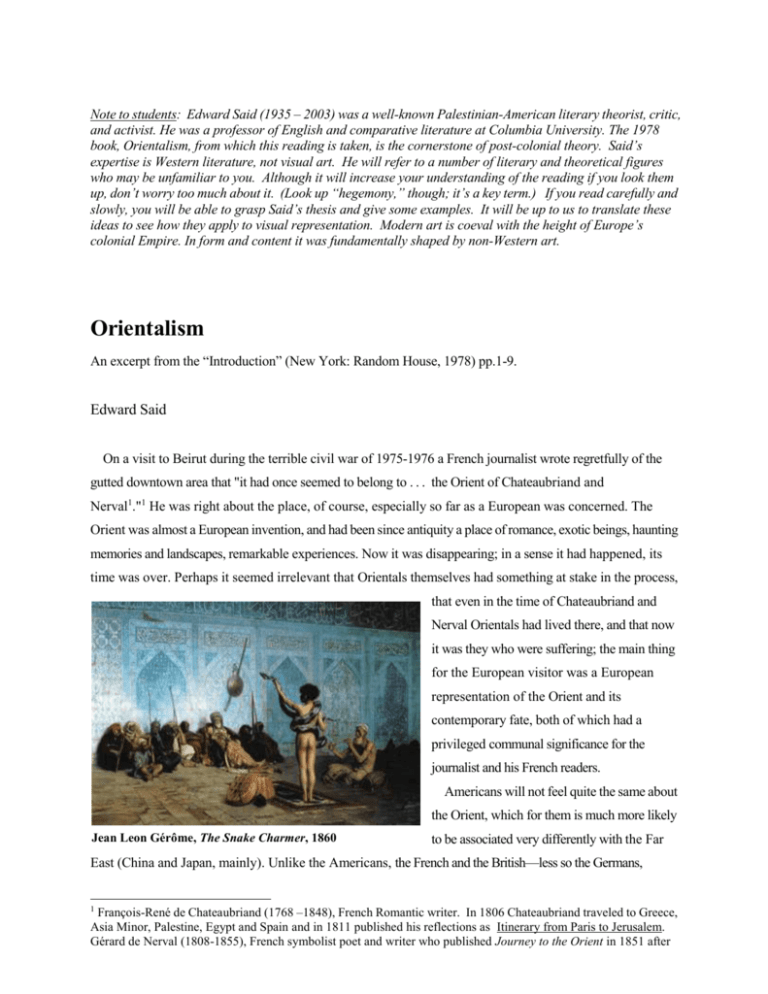
Note to students: Edward Said (1935 – 2003) was a well-known Palestinian-American literary theorist, critic, and activist. He was a professor of English and comparative literature at Columbia University. The 1978 book, Orientalism, from which this reading is taken, is the cornerstone of post-colonial theory. Said’s expertise is Western literature, not visual art. He will refer to a number of literary and theoretical figures who may be unfamiliar to you. Although it will increase your understanding of the reading if you look them up, don’t worry too much about it. (Look up “hegemony,” though; it’s a key term.) If you read carefully and slowly, you will be able to grasp Said’s thesis and give some examples. It will be up to us to translate these ideas to see how they apply to visual representation. Modern art is coeval with the height of Europe’s colonial Empire. In form and content it was fundamentally shaped by non-Western art. Orientalism An excerpt from the “Introduction” (New York: Random House, 1978) pp.1-9. Edward Said On a visit to Beirut during the terrible civil war of 1975-1976 a French journalist wrote regretfully of the gutted downtown area that "it had once seemed to belong to . . . the Orient of Chateaubriand and Nerval1."1 He was right about the place, of course, especially so far as a European was concerned. The Orient was almost a European invention, and had been since antiquity a place of romance, exotic beings, haunting memories and landscapes, remarkable experiences. Now it was disappearing; in a sense it had happened, its time was over. Perhaps it seemed irrelevant that Orientals themselves had something at stake in the process, that even in the time of Chateaubriand and Nerval Orientals had lived there, and that now it was they who were suffering; the main thing for the European visitor was a European representation of the Orient and its contemporary fate, both of which had a privileged communal significance for the journalist and his French readers. Americans will not feel quite the same about the Orient, which for them is much more likely Jean Leon Gérôme, The Snake Charmer, 1860 to be associated very differently with the Far East (China and Japan, mainly). Unlike the Americans, the French and the British—less so the Germans, François-René de Chateaubriand (1768 –1848), French Romantic writer. In 1806 Chateaubriand traveled to Greece, Asia Minor, Palestine, Egypt and Spain and in 1811 published his reflections as Itinerary from Paris to Jerusalem. Gérard de Nerval (1808-1855), French symbolist poet and writer who published Journey to the Orient in 1851 after 1 Russians, Spanish, Portuguese, Italians, and Swiss—have had a long tradition of what I shall be calling Orientalism, a way of coming to terms with the Orient that is based on the Orient's special place hi European Western experience. The Orient is not only adjacent to Europe; it is also the place of Europe's greatest and richest and oldest colonies, the source of its civilizations and languages, its cultural contestant, and one of its deepest and most recurring images of the Other. In addition, the Orient has helped to define Europe (or the West) us its contrasting image, idea, personality, experience. Yet none of this Orient is merely imaginative. The Orient is an integral part of European material civilization and culture. Orientalism expresses and represents that part culturally and even ideologically as a mode of discourse with supporting institutions, vocabulary, scholarship, imagery, doctrines, even colonial bureaucracies and colonial styles. In contrast, the American understanding of the Orient will seem considerably less dense, although our recent Japanese, Korean, and Indochinese adventures ought now to be creating a more sober, more realistic "Oriental" awareness. Moreover, the vastly expanded American political and economic role in the Near East (the Middle East) makes great claims on our understanding of that Orient. It will be clear to the reader (and will become clearer still throughout the many pages that follow) that by Orientalism I mean several things, all of them, in my opinion, interdependent. The most readily accepted designation for Orientalism is an academic one, and indeed the label still serves in a number of academic institutions. Anyone who teaches, writes about, or researches the Orient—and this applies whether the person is an anthropologist, sociologist, historian, or philologist—either in its specific or its general aspects, is an Orientalist, and what he or she does is Orientalism. Compared with Oriental studies or area studies, it is true that the term Orientalism is less preferred by specialists today, both because it is too vague and general and because it connotes the high-handed executive attitude of nineteenth-century and early-twentieth-century European colonialism. Nevertheless books are written and congresses held with "the Orient" as their main focus, with the Orientalist in his new or old guise as their main authority. The point is that even if it does not survive as it once did, Orientalism lives on academically through its doctrines and theses about the Orient and the Oriental. Related to this academic tradition, whose fortunes, transmigrations, specializations, and transmissions are in part the subject of this study, is a more general meaning for Orientalism. Orientalism is a style of thought based upon an ontological and epistemological Henri Matisse, Blue Nude (Souvenir de Biskra) 1907, oil on canvas. Baltimore extensive travel to Cairo and Beirut. distinction made between "the Orient" and (most of the time) "the Occident." Thus a very large mass of writers, among whom are poets, novelists, philosophers, political theorists, economists, and imperial administrators, have accepted the basic distinction between East and West as the starting point for elaborate theories, epics, novels, social descriptions, and political accounts concerning the Orient, its people, customs, "mind," destiny, and so on. This Orientalism can accommodate Aeschylus, say, and Victor Hugo, Dante and Karl Marx. A little later in this introduction I shall deal with the methodological problems one encounters in so broadly construed a "field" as this. The interchange between the academic and the more or less imaginative meanings of Orientalism is a constant one, and since the late eighteenth century there has been a considerable, quite disciplined—perhaps even regulated—traffic between the two. Here I Paul Klee, Hammamet with Its Mosque, 1914, watercolor and pencil on paper come to the third meaning of Orientalism, which is something more historically and materially denned than either of the other two. Taking the late eighteenth century as a very roughly denned starting point Orientalism can be discussed and analyzed as the corporate institution for dealing with the Orient—dealing with it by making statements about it, authorizing views of it, describing it, by teaching it, settling it, ruling over it: in short, Orientalism as a Western style for dominating, restructuring, and having authority over the Orient. I have found it useful here to employ Michel Foucault's notion of a discourse, as described by him in The Archaeology of Knowledge and hi Discipline and Punish, to identify Orientalism. My contention is that without examining Orientalism as a discourse one cannot possibly understand the enormously systematic discipline by which European culture was able to manage—and even produce—the Orient politically, sociologically, militarily, ideologically, scientifically, and imaginatively during the post-Enlightenment period. Moreover, so authoritative a position did Orientalism have that I believe no one writing, thinking, or acting on the Orient could do so without taking account of the limitations on thought and action imposed by Orientalism. In brief, because of Orientalism the Orient was not (and is not) a free subject of thought or action. This is not to say that Orientalism unilaterally determines what can be said about the Orient, but that it is the whole network of interests inevitably brought to bear on (and therefore always involved in) any occasion when that peculiar entity "the Orient" is in question. How this happens is what this book tries to demonstrate. It also tries to show that European culture gained in strength and identity by setting itself off against the Orient as a sort of surrogate and even underground self. Historically and culturally there is a quantitative as well as a qualitative difference between the Franco-British involvement in the Orient and—until the period of American ascendancy after- vation that men make their own history, that what they can know is what they have made, and extend it to geography: as both geographical and cultural entities—to say nothing of historical entities —such locales, regions, geographical sectors as "Orient" and "Occident" are man-made. Therefore as much as the West itself, the Orient is an idea that has a history and a tradition of thought, imagery, and vocabulary that have given it reality and presence in and for the West. The two geographical entities thus support and to an extent reflect each other. Having said that, one must go on to state a number of reasonable qualifications. In the first place, it would be wrong to conclude that the Orient was essentially an idea, or a creation with no corresponding reality. When Disraeli said in his novel Tancred that the East was a career, he meant that to be interested in the East was something bright young Westerners would find to be an all-consuming passion; he should not be interpreted as saying that the East was only a career for Westerners. There were – and are – cultures and nations whose location is in the East, and their lives, histories, and customs have a brute reality obviously greater than anything that could be said about them in the West. About that fact this study of Orientalism has very little to contribute, except to acknowledge it tacitly. But the phenomenon of Orientalism as I study it here deals principally, not with a correspondence between Orientalism and Orient, but with the internal consistency of Orientalism and its ideas about the Orient (the East as career) despite or beyond any correspondence, or lack thereof, with a "real" Orient. My point is that Disraeli's statement about the East refers mainly to that created consistency, that regular constellation of ideas as the pre-eminent thing about the Orient, and not to its mere being, as Wallace Stevens's phrase has it. A second qualification is that ideas, cultures, and histories cannot seriously be understood or studied without their force, or more precisely their configurations of power, also being studied. To believe that the Orient was created – or, as I call it, "Orientalized" – and to believe that such things happen simply as a necessity of the imagination, is to be disingenuous. The relationship between Occident and Orient is a relationship of power, of domination, of varying degrees of a complex hegemony, and is quite accurately indicated in the title of K. M. Panikkar's classic Asia and Western Dominance.2 The Orient was Orientalized not only because it was discovered to be "Oriental" in all those ways considered common – World War II – the involvement of every other European and Atlantic power. To speak of Orientalism therefore is to speak mainly although not exclusively, of a British and French cultural enterprise, a project whose dimensions take in such disparate realms as the imagination itself, the whole of India and the Levant, the Biblical texts and the Biblical lands, the spice trade, colonial armies and a long tradition of colonial administrators, a formidable scholarly corpus, innumerable Oriental "experts" and "hands," an Oriental professorate, a complex array of "Oriental" ideas (Oriental despotism, Oriental splendor, cruelty, sensuality), many Eastern sects, philosophies, and wisdoms domesticated for local European use—the list can be extended more or less indefinitely. My point is that Orientalism derives from a particular closeness experienced between Britain and France and the Orient, which until the early nineteenth century had really meant only India and the Bible lands. From the beginning of the nineteenth century until the end of World War II France and Britain dominated the Orient and Orientalism; since World War II America has dominated the Orient, and approaches it as France and Britain once did. Out of that closeness, whose dynamic is enormously productive even if it always demonstrates the comparatively greater strength of the Occident (British, French, or American), comes the large body of texts I call Orientalist. It should be said at once that even with the generous number of books and authors that I examine, there is a much larger number that I simply have had to leave out. My argument, however, depends neither upon an exhaustive catalogue of texts dealing with the Orient nor upon a clearly delimited set of texts, authors, and ideas that together make up the Orientalist canon. I have depended instead upon a different methodological alternative—whose backbone in a sense is the set of historical generalizations I have so far been making in this Introduction—and it is these I want now to discuss in more analytical detail. II I have begun with the assumption that the Orient is not an inert fact of nature. It is not merely there, just as the Occident itself is not just there either. We must take seriously Vico's great obser place by an average nineteenth-century European, but also because it could be—that is, submitted to being—made Oriental. There is very little consent to be found, for example, in the fact that Flaubert's encounter with an Egyptian courtesan produced a widely influential model of the Oriental woman; she never spoke of herself, she never represented her emotions, presence, or history. He spoke for and represented her. He was foreign, comparatively wealthy, male, and these were historical facts of domination that allowed him not only to possess Kuchuk Hanem physically but to speak for her and tell his readers in what way she was "typically Oriental." My argument is that Flaubert's situation of strength in relation to Kuchuk Hanem was not an isolated instance. It fairly stands for the pattern of relative strength between East and West, and the discourse about the Orient that it enabled. This brings us to a third qualification. One ought never to assume that the structure of Orientalism is nothing more than a structure of lies or of myths which, were the truth about them to be told, would simply blow away. I myself believe that Orientalism is more particularly valuable as a sign of European-Atlantic power over the Orient than it is as a veridic discourse about the Orient (which is what, in its academic or scholarly form, it claims to be). Nevertheless, what we must respect and try to grasp is the sheer knitted-together strength of Orientalist discourse, its very close ties to the enabling socio-economic and political institutions, and its redoubtable durability. After all, any system of ideas that can remain unchanged as teachable wisdom (in academies, books, congresses, universities, foreign-service institutes) from the period of Ernest Renan in the late 1840s until the present in the United States must be something more formidable than a mere collection of lies. Orientalism, therefore, is not an airy European fantasy about the Orient, but a created body of theory and practice in which, for many generations, there has been a considerable material investment. Continued investment made Orientalism, as a system of knowledge about the Orient, an accepted grid for filtering through the Orient into Western consciousness, just as that same investment multiplied—indeed, made truly productive—the statements proliferating out from Orientalism into the general culture. Gramsci has made the useful analytic distinction between civil and political society in which the former is made up of voluntary (or at least rational and noncoercive) affiliations like schools, families, and unions, the latter of state institutions (the army, the police, the central bureaucracy) whose role in the polity is direct domination. Culture, of course, is to be found operating within civil society, where the influence of ideas, of institutions, and of other persons works not through domination but by what Gramsci calls consent. In any society not totalitarian, then, certain cultural forms predominate over others, just as certain ideas are more influential than others; the form of this cultural leadership is what Gramsci has identified as hegemony, an indispensable concept for any understanding of cultural life in the industrial West. It is hegemony, or rather the result of cultural hegemony at work, that gives Orientalism the durability and the strength I have been speaking about so far. Orientalism is never far from what Denys Hay has called the idea of Europe,3 a collective notion identifying "us" Europeans as against all "those" non-Europeans, and indeed it can be argued that the major component in European culture is precisely what made that culture hegemonic both in and outside Europe: the idea of European identity as a superior one in comparison with all the non-European peoples and cultures. There is in addition the hegemony of European ideas about the Orient, themselves reiterating European superiority over Oriental backwardness, usually overriding the possibility that a more independent, or more skeptical, thinker might have had different views on the matter. In a quite constant way, Orientalism depends for its strategy on this flexible positional superiority, which puts the Westerner in a whole series of possible relationships with the Orient without ever losing him the relative upper hand. And why should it have been otherwise, especially during the period of extraordinary European ascendancy from the late Renaissance to the present? The scientist, the scholar, the missionary, the trader, or the soldier was in, or thought about, the Orient because he could be there, or could think about it, with very little resistance on the Orient's part. Under the general heading of knowledge of the Orient, and within the umbrella of Western hegemony over the Orient during the period from the end of the eighteenth century, there emerged a complex Orient suitable for study in the academy, for display in the museum, for reconstruction in the colonial office, for theoretical illustration in anthropological, biological, linguistic, racial, and historical theses about mankind and the universe, for instances of economic and sociological theories of development, revolution, cultural personality, national or religious character. Additionally, the imaginative examination of things Oriental was based more or less exclusively upon a sovereign Western consciousness out of whose unchallenged centrality an Oriental world emerged, first according to general ideas about who or what was an Oriental, then according to a detailed logic governed not simply by empirical reality but by a battery of desires, repressions, investments, and projections. If we can point to great Orientalist works of genuine scholarship like Silvestre de Sacy's Chrestomathie arabe or Edward William Lane's Account of the Manners and Customs of the Modern Egyptians, we need also to note that Renan's and Gobineau's racial ideas came out of the same impulse, as did a great many Victorian pornographic novels (see the analysis by Steven Marcus of "The Lustful Turk"4). And yet, one must repeatedly ask oneself whether what matters in Orientalism is the general group of ideas overriding the mass of material—about which who could deny that they were shot through with doctrines of European superiority, various kinds of racism, imperialism, and the like, dogmatic views of "the Oriental" as a kind of ideal and unchanging abstraction?—or the much more varied work produced by almost uncountable individual writers, whom one would take up as individual instances of authors dealing with the Orient. In a sense the two alternatives, general and particular, are really two perspectives on the same material: in both instances one would have to deal with pioneers in the field like William Jones, with great artists like Nerval or Flaubert. And why would it not be possible to employ both perspectives together, or one after the other? Isn't there an obvious danger of distortion (of precisely the kind that academic Orientalism has always been prone to if either too general or too specific a level of description is maintained systematically? My two fears are distortion and inaccuracy, or rather the kind of inaccuracy produced by too dogmatic a generality and too positivistic a localized focus. In trying to deal with these problems I have tried to deal with three main aspects of my own contemporary reality that seem to me to point the way out of the methodological or perspectival difficulties I have been discussing, difficulties that might force one, in the first instance, into writing a coarse polemic on so unacceptably general a level of description as not to be worth the effort, or in the second instance, into writing so detailed and atomistic a series of analyses as to lose all track of the general lines of force informing the field, giving it its special cogency. How then to recognize individuality and to reconcile it with its intelligent, and by no means passive or merely dictatorial, general and hegemonic context? (…) NOTES: 1. Thierry Desjardins, Le Martyre du Liban (Paris: Plon, 1976), p. 14. 2. K. M. Panikkar, Asia and Western Dominance (London: George Alien & Unwin, 1959). 3. Denys Hay, Europe: The Emergence of an Idea, 2nd ed. (Edinburgh: Edinburgh University Press, 1968). 4. Steven Marcus, The Other Victorians: A Study of Sexuality and Pornography in Mid-Nineteenth Century England (1966; reprint ed., New York: Bantam Books, 1967), pp. 200-19. 5. See my Criticism Between Culture and System (Cambridge, Mass.: Harvard University Press, forthcoming).
